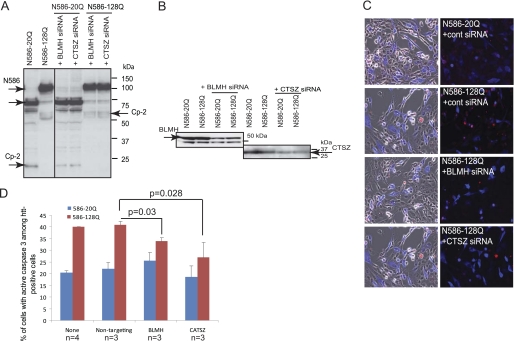FIGURE 7.
Knockdown of BLMH or cathepsin Z ameliorates mutant Htt toxicity in HT22 cells. A, HT22 cells were co-transfected with either normal (N586–20Q) or polyQ expanded (N586–128Q) Htt constructs and siRNA pools to BLMH or cathepsin Z (CTSZ). A line shown between gel samples indicate that the samples obtained from the same experiment were run on different parallel gels at the same time. B, endogenous BLMH and cathepsin Z expression in HT22 cells and their knockdown detected with protease-specific antibodies. C, immunofluorescent detection of either normal (N586–20Q) or mutant (N586–128Q) Htt with an antibody to residues 1–82 is shown in blue (Alexa Fluor 350), and active caspase-3 is shown in red (Cy3). D, the graph shows percentage of cells with activated caspase-3 among transfected cells stained with an Htt-specific antibody. At least 200–300 cells were counted for each condition in one experiment. The experiment was repeated three or four times (n = 3 or n = 4; p = 0.03 nontargeting siRNA versus BLMH siRNA with Htt-N586–128Q; p = 0.028 nontargeting siRNA versus cathepsin Z siRNA with Htt-N586–128Q). cont, control.

